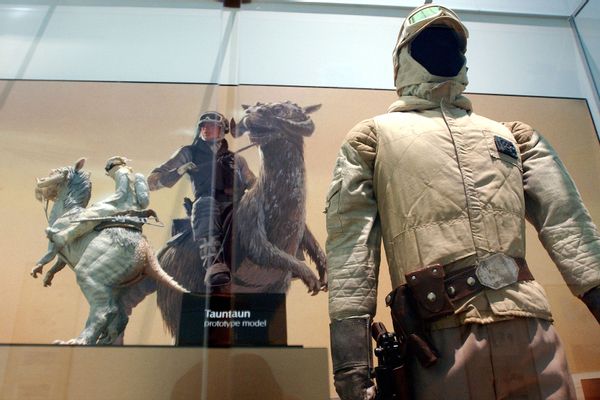
In a galaxy far, far, away, amid knights dueling with laser swords and droids spewing blaster fire and fractured galactic alliances, it can be difficult to focus on, well, anything but.
The most superficial images that come to mind when I think of Star Wars are spinning blue and red lightsabers, the Skywalker home and Tatooine’s binary sunset dipping below the horizon, Darth Sidious’ drooping skin and of course, Princess Leia’s gold bikini.
These are all highly recognizable, definitive fixtures of the franchise — and yet, they never did it for me, emotionally speaking, the way the films’ creatures did.
I’ll preface this commentary by saying that my familiarity with Star Wars doesn’t extend much further than the first six episodes. But the array of extraterrestrial creatures in those films alone was enough to instill a sense of empathy in me more than any celestial love story or father-son reunification ever could. In a fictional space realm, the largely unplumbed stories of Star Wars’ creatures give us something real and undeniably affecting to cling to.
I was first introduced to the Star Wars universe in my youth by my mother. A child of the '70s, my mom had fallen in love with the first three films during their initial heyday, eventually pulling my dad into the fandom after they began dating in high school.
As a kid, I'd ogled my mom’s preteen scrapbooks in secret many times: laminated, yellowy paper pasted with images of Harrison Ford posing for photoshoots dressed as his character from Episodes IV, V and VI: the handsome and brash pirate-pilot, Han Solo. Soon enough, Episodes I-VI became canon in my household. We’d rotate the DVD copies of each film arbitrarily and consistently binge them during the Christmas break rot period, along with “Harry Potter” and “The Lord of the Rings.” Phrases like Admiral Ackbar’s throaty, “It’s a trap!” — uttered as star destroyers descend upon the Rebel Alliance outside the second Death Star in “Return of the Jedi” — were used colloquially amongst the seven of us long before it was flipped into a meme. To my adolescent annoyance, my mom often employed Yoda’s infamous, “Do. Or do not. There is no try,” when I whined about school or sports. And for years, one of my sisters and I have referred to each other as Salacious Crumb, Jabba the Hutt’s shrill-voiced and crusty little jester, whenever one of us looks particularly unseemly.

They inculcated my siblings and me with a deep love for living creatures of all kinds; my family home has never been without at least three or so pets. Coupled with their deep appreciation for George Lucas’ imaginative world, it’s no surprise that animals like the Rancor, featured in “Return of the Jedi,” engendered a strong sense of compassion in me. We recently saw the massive reptilian monster in Disney+’s spinoff series, “The Book of Boba Fett,” where he was given as a gift to the bounty hunter by The Twins, a villainous Hutt duo.
I was never put off by his lumpy, leathery body, nor his hooked claws. Jabba, in all his hulking space worminess, was far more detestable. The Rancor’s enclosure always seemed much too small for his size, too. I thought of him sympathetically whenever I saw a Great Dane or German Shepherd traipsing through the cramped stairwells of my first Manhattan apartment, wondering how on earth someone could subject such a large dog to such modest square footage.
And sure, if Luke hadn’t killed the Rancor by launching a rock at the enclosure door, letting it slam down on the creature, he would have been eaten alive and the Hutt would still have Han cemented in carbonite/Leia as his dancing slave. But hearing the Rancor eke out a final last breath (which sounds unsettlingly like a canine whine) as his knobbed and gnarled claws drop to the ground, lifeless, is enough to make anyone’s eyes rim red. His pet-like aura is confirmed when a guard, presumably his master, rushes into the sand-floored pit to find the Rancor dead and immediately begins to cry.

“This may smell bad, kid. But it’ll keep you warm,” Han says to Luke, who is semi-consciously blabbering about the swampy Dagobah system, which Obi-Wan Kenobi’s Force spirit instructed him to go to.
The tauntuan’s gentle face and braying cry definitely lend themselves to our responsiveness to it. However, this argument is harder won in the case of the Acklay, the Nexus, and the Reek, the three alien creatures Padme Amidala, Anakin Skywalker, and Obi-wan are made to square off against in an arena on the planet Geonosis after being captured at a droid factory.
The whole setup is strongly reminiscent of a gladiator fight in ancient Rome’s Colosseum, which was known to have witnessed the deaths of thousands of lions, bears, elephants, panthers and leopards. This image makes the beasts’ deaths even more tragic, as they’re likely confused and fearful. They may even be tranquil in nature, but we wouldn’t know — winged, insectoid Geonsians poke and prod at them with electrified spears to incite their anger.
Our identification with the reek — which looks vaguely like a tri-horned rhino with a ruddy-colored face — specifically grows as the scene progresses. Anakin is able to use his chains to harness the beast, which permits him to ride it around the area throughout the Jedi-droid battle that ensues shortly after.
A sharp but necessary pivot from scales and talons brings me to Star Wars’ most adorable animals: Ewoks, the sweet, cherubic creatures that populate the forest moon of Endor in “Return of the Jedi.” As a toddler, one of my younger sisters had a furry brown coat affixed with tiny ears. Naturally, my family would often refer her as Baby Ewok whenever she wore it.
While it’s easy to infantilize these furry, arboreal critters — a key reason why audiences’ hearts have been moved by them for decades — their cuteness should never eclipse their importance, as the Ewok tribe holds a pivotal role in the destruction of the Death Star. After Emperor Palpatine’s Imperial forces apprehend the Rebels, the Ewoks launch a surprise counterattack that dismantles the clones and lets Han Solo’s squadron infiltrate the shield generator for the lethal, moon-sized space station.
While the Ewoks’ courageous move allows the rebels to clinch a crucial victory, it doesn’t come without some devastating losses. Ahead of the win, clone-controlled AT-DT artillery walkers prowl the forest on two spindly legs, blasting everything in their path. In what is one of the most heartrending scenes in the franchise, two Ewoks are struck by an explosion as they’re scurrying for shelter. Upon being hit, one of them emits what sounds nearly identical to a human baby’s cry. Its companion escapes unscathed and tries to rouse his friend to no avail. We’re left with a frame of the survivor leaning over his comrade, wailing in an obvious state of grief.
From the whimsical to the sacrificial, a number of Star Wars’ non-human creatures produce some of the most visceral sentiments contained within the films. Science fiction and fantasy aficionados may argue that, in the case of a space opera like Star Wars, highlighting these characters is hardly the point — that it’s about immersive visuals and the thought-provoking experience of contemplating alternate universes and hyper-advanced technologies.
While those are certainly viable and earnest reasons for the massive success of a multi-film franchise like Star Wars, all of which I share, the deep-seated connection I feel with the movies’ otherworldly animate beings is both indelible and far more profound. It may be the sensitive Pisces in me, but I’ll be thinking about tauntaun guts whenever I get around to watching “The Revenant.”







